This page represents an interview I had the honour to conduct with National Geographic wildlife photographer Steve Winter, see him speak, and share his photos. His passion for big cats and their survival shines through everything we discussed. The text below has remained virtually unchanged since the interview in 2015.
Some of us do get to live out our dream.
Steve Winter, one of the National Geographic Wildlife Photographers, is one of those few. Aside from being an incredibly talented and patient photographer, Steve Winter is a nice guy.
Down to earth and friendly, he speaks with a passion and enthusiasm that beams through in the stories he tells; sometimes with words, more often with photos. I was lucky enough to get to interview him last week.
Steve was given his first camera at age seven and began learning about photography from his dad. Only a year later, at the young age of 8, he knew he wanted to be a National Geographic photojournalist, and since 1991 he has been living the dream of just about every photographer I know, myself included.
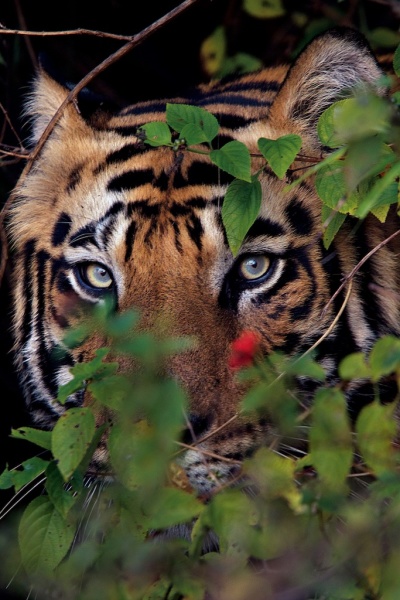
Photo Credit: ©Steve Winter. Used with permission.
An interview with Steve Winter Photographer
Q. When I was young, I had photos of lions hanging on my walls. I wanted to be a National Geographic big cat photographer. I was young, and it appeared glamorous and exciting, but after reading several of your articles, I know that it isn’t. What’s it really like?
I know there is no typical day, but how about the steps involved in doing one of your assignments for National Geographic?
I think one of the important things is the preparation that nobody knows about. Let’s talk about my current India one. I had to spend months to be able to work in a Tiger Reserve (in National Parks); I have to go through the National Tiger Conservation Authority and then go to the Ministry of Environment to get permits.
Even before that I have to talk to people to find out where I would find leopards, what would be interesting to the readers and what are the conflict issues with these animals since they do live close to humans. Next, I run all this by my editor and we try to figure out what to do and what not to do. I have to be sure that all those things are possible while I’m in country and then get those permits.
Finally I get a visa, which this time took 2 ½ months, much longer than normal and the whole shoot lost quite a bit of time. It was terrible. Instead of having 2 months in India and one month in Sri Lanka I had one month in India.”
Q. How big is your team?
I keep it small. I use a lot of local people because who knows better about the animals around where I want to work than the people that actually live there. So I have three (local) guys in Mumbi and I have two people that work for me
. Nowadays, the way technology is even with a TV show you can get away with not too many people. You don’t want too many people doing animals in my estimation. Some people would disagree.”
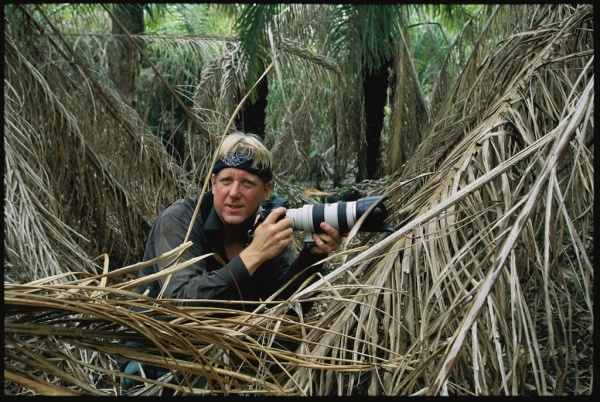
Photo Credit: ©Steve Winter. Used with permission.
Q. So, who keeps you safe?
I rely on the people that I work with, the local people, and I rely on my experience. I also rely on the fact that fear is a very important part of our nature. If you are not fearful, you are foolish and maybe dead.
I didn’t know any of this. I learned it by experience. People will asked me “How do you get so close to that animal?” and every once in a while in the beginning I thought, ‘what am I doing here?’ And then I turn to the person that I’m with, going, you know what you’re doing so I don’t have to worry. Other people ask, ‘Do you always have a gun with you?‘ How about 10% of the time or less.
You have to use the knowledge of the people that you’re working with to keep you safe and your experience. I’ve seen people do stupid things and (thought), not only are they going to get themselves killed, but they might get me killed. Guess what; that is not in the game plan. I have a family and I’ve made it 25 years doing this without being injured by anything other than microscopic animals, which are bad enough, so I’ve been lucky.”
Q. Are you still shooting with Canon and using Apple software?
Yep. There’s a couple of us that are not giving up on (Apple’s) Aperture yet and Canon is my brand, though our remote cameras now are Nikons, but it’s for a very specific reason. It’s a pain carrying Nikon lenses and cameras for your camera traps and all Canon gear for everything else. Canon UK and Canon USA are wonderful and they are supporting us.”
Q. How much set-up goes into each of those photos that you have in National Geographic Magazines?
It really depends. The last mountain lion story I did was obviously primarily camera traps. Like snow leopards, you are going to be lucky if you see one, and if you do you better have an incredibly long lens. So a lot of set up. Let’s pick Hollywood cougars as an example: I spent months working with the biologist that collars the cats north of LA in the Santa Monica National Recreation Area. He put a collar on a cat, but it didn’t work so I get a grant then we can find out where the cat goes.
Then I walk all of the trails in Griffith Park trying to figure out where this cat goes so I can get the Hollywood sign and LA (in the background). I move the camera five times. It took 15 months to get the picture altogether. It’s an incredible amount of work that people don’t realize. I need to find the spot where I would put that camera where I would take the picture myself; As if I were lying on the ground and the cat would actually walk by, which it wouldn’t because it would smell me. You can’t do it with a long lens because it’s illegal to be in the park after ten o’clock at night.”
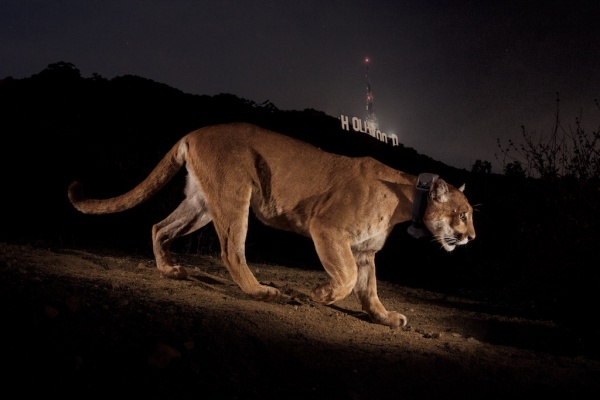
Photo Credit: ©Steve Winter Photography. Used with permission.
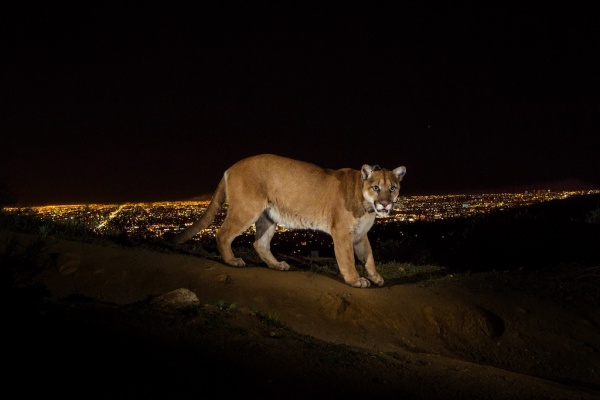
Photo Credit: ©Steve Winter Photography. Used with permission.
(Referring to his recent trip to India)
Once you start meeting people, and people know you’re an honest guy, and trust you, that’s one of the biggest things you need to do; is to gain people’s trust. In India they said we trust you because your National Geographic but our local media
just wants to show all the bad stuff.”
Q. The world of photojournalism is changing. You studied fine arts and photography. What advice and cautions do you have for young people looking for a photojournalism career?
Well I would say that for me I don’t think it’s actually changed. I ended up going to IU with my high school buddies. However, I would tell everybody that I think University of Missouri is still the best (for photojournalism). We work with them closely at National Geographic. After IU I went around the world and ended up in Art School. What did I learn in Art School? How to have fun. I got my education as an assistant when I left school. Being an assistant is really vital because you learn on the job training.
And learning to be a visual story teller. You can take this from Bob Gilka who said it back in the 70s, show me a story that somebody did 15 miles from where they live and I like it, I’ll give them a job. Most people think they have to travel halfway around the world to see exotic cultures to be able to do a story. No, there’s a story probably right where you live, within the distance that you can see, family, someone down the street, some organization down the street, in your town, etc. I ended up doing this totally by accident. It didn’t cost much to do it except in time and gas. I worked at the same time.
I will tell you I have watched the director of photography at National Geographic look at portfolios and you don’t think she’s looking, but she spent 25 years as a National Geographic Photographer. She’s not looking for those single images, though she is, but she’s looking for that story, primarily because that’s what we do, we tell stories.
If every image is killer you’re really lucky but if they at least tell a visual story then you’ve done your job and the hardest part of doing this when you’re young and when you’re older is being a tough editor. I’m a crappy editor. I need someone to help me tell the story because I’m too personally involved in the images. You really have to be able to tell a story, whether its in words, or images or moving images and the best place to do it is close to home, I believe.”
* * * * * * *
Final thoughts
I opted not to repeat the traditional background questions that he has answered so many times before. If you want to read about how he got started, check out one of these articles:
- Steve Winter, Wildlife Photojournalist, Speaker, Presenter (From SteveWinterPhoto.com)
- Behind the Lens with Steve Winter (Popular Photography)
- Steve Winter (The Photo Society)
Check out Steve Winter’s book
If you can’t make one of his presentations, or even if you can check out Steve Winter’s book: Tigers Forever: Saving the World’s Most Endangered Big Cat
What most fascinated you about Steve Winter?
You might also like…
- Dive Tatapouri: Wild Stingray Feeding, Gisborne New Zealand
- Our Auckland whale-watching afternoon spotting dolphins, whales & birds
- Juneau Whale Watching, Glaciers, and Other Juneau Cruise Port Ideas
- Batu Caves: Monkeys, Statues, and Hindu Shrines Are Worth a Visit
- 5 Destinations Perfect for Wildlife Adventures


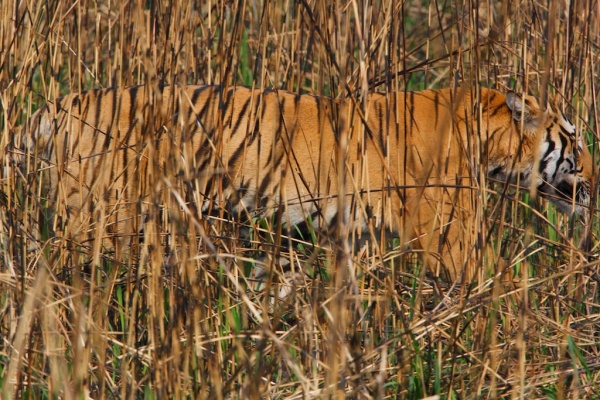
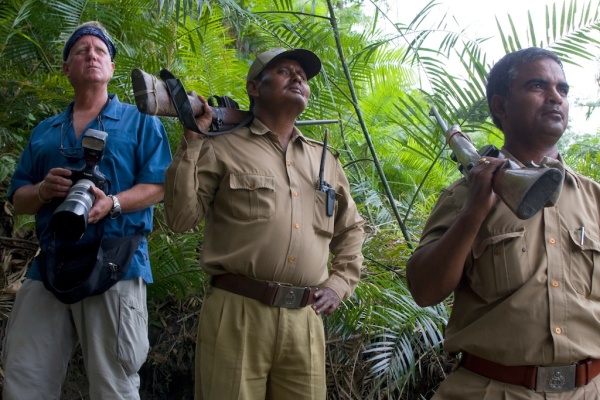
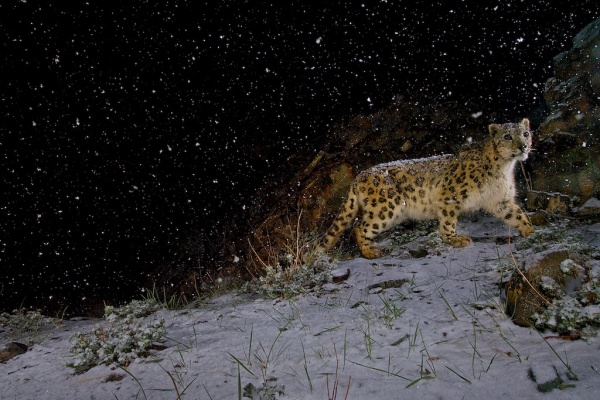
Todd @ Visit50
Awesome photos! How do you like your mirrorless camera? Which did you get? I’ve been using an old Nikon D40, which has been solid, but I’m finally ready to upgrade.
Rhonda Albom
I love my camera. It is light weight and has all the manual features of my DSLR. It is an Olympus OMD – EM5. The only downside is the lowest ISO is 200, but I have an ND filter now.
Corinne
What a great interview. I love the “storytelling” aspect, something we all shoot for!
Madilyn Quinn
Interesting interview! I had no idea the work that went behind these gorgeous photos!
Rhonda Albom
I look at the photos a bit differently now that I know. They are more than just stunning.
rajlakshmi
it’s so amazing to read about Steve’s journey and his experience. The pictures are gorgeous
Momfever
Wow that’s really impressive. Tigers are beautiful.
Rhonda Albom
It’s too bad some people killing them off. Let’s hope that people like Steve Winter can make a difference.
Hawk aka BrownDog
Hi Y’all!
Those are amazing photos. So much fun to find them here instead of National Geo.
Y’all come on by,
Hawk aka BrownDog
Charlotte
Amazing photos!
Rachael@safari254
His work is amazing! I can’t believe you got to interview him. Interesting read.
Shellie Bowdoin
Interesting, you see the pics but often don’t consider that someone had to be right there to capture them!
Shellie
Rhonda Albom
I had read before about how long Steve had waited for some shots, but I was surprised by just how much prep goes in to the plan even before he arrives at the location.
Hilary
Hi Rhonda – what an amazing interview and interesting info he passed on – love those photos .. and yes to be that dedicated to his passion and love of animals and photography. Enjoy getting to one of his shows …
Cheers Hilary
PippaD @ A Mother's Ramblings
I am so jealous, these images are brilliant and so informative.
Mary Denman
So glad you were able to interview Steve and share with us Rhonda! You did a great job. I’m planning on reading more about him.
One thing that struck me is the behind-the-scenes work. I’ve seen a Nat Geo special that followed one of their photographers. They work HARD for us to enjoy the photos.
The other thing that struck me is that Nat Geo isn’t all about perfect shots, but telling a story. That’s exciting to me! And it makes sense if you think about their articles.
Thanks for sharing!
Joyce
Beautiful photos!
I would tell everybody that I think University of Missouri is still the best (for photojournalism).
Missourah! Missourah! Tigers! Where else would he film one?
Rhonda Albom
LOL – You know, I never thought about the “Tigers” connection. I knew you would appreciate him mentioning our old school, Mizzou. I had to interrupt for just a moment, before he said anything bad about it to let him know I went there.
Indrani
Great you got to interview him!
A very interesting read on him.
Nancy
Fascinating animals – and he’s captured them beautifully!
Quirky Homemaker
How exciting that you got to interview Steve Winter. His images are amazing. Love all the tigers. Thanks for sharing him with us!
Patrick Weseman
Super interview and he has been someone that I have admired for a while. I love his pics.
http://csuhpat1.blogspot.com/2015/06/movie-jewelery-by-joseff-of-hollywood.html
Karren Haller
What amazing photos, the big cats are wonderful, we love to watch shows about them.
Rhonda Albom
The cool thing about seeing them on TV is that you can get closer than you could if you actually saw them live. Although, seeing them live would be really incredible.
Parent Club
What an amazing experience for a photographer!
Rhonda Albom
Being out there and seeing those animals would be worth all that prep work. Since that will never happen for me, being able to interview and see Steve Winter live is probably as close as I will ever come.
Teresa from NanaHood
That was a great post with beautiful pictures. What a story! What a life he has led! Thank you for sharing!
stephanie@stephsjoy
He is an amazing photographer! the photos of the tiger had me captivated!
Merlinda Little
My current fave among your post! I read it 2x! I dont want to miss the details of the interview. Amazing post here and his answers are so nice to read. You are so lucky to have this interview!
Leovi
Thank you very much! How wonderful photos of Steve Winter !!!
Denise Covey
Hi Rhonda
How incredible to have Steve on your site, and sharing so much with us all. No better place to go for wildlife photography than National Geographic. Wonderful. Inspirational.
Denise 🙂
Amila @Leisure and Me
Great interview to read,specially their experiences in the jungle when capturing these amazing photographs.
Virginia Allain
That was fascinating. I guess all of us fancy becoming good enough for National Geographic once we get our hands on a camera. You are a lot further down that path than I will ever be.
Lisa Howard
National Geographic photographers are my heroes. Not only are they amazing, hard-working artists, but they show us things that many of us would never be able to see in person. I was lucky enough to see tigers in the wild when I visited India 25 years ago, but I fear my children will never see big cats in the wild because we are going to kill them all. People like Steve, however, give me hope. They make people see the beauty of these creatures, and perhaps that will inspire us to work harder to save them. Great interview!
Rhonda Albom
I agree completely, he is one of the earth’s heroes, and I do hope his work makes a difference. How very cool that you saw tigers in the wild, and I hope that your children will get to one day too.
Suze The Luxury Columnist
Wow, I’m in awe of Steve’s photos of the tigers and also the cougar with the Hollywood sign in the background. I love the concept of striving to be a visual storyteller and I think it can apply to all bloggers too
Rhonda Albom
He has so many amazing shots which tell a story. It is a skill he has mastered. I think we are all in awe of some of those shots.
Cherie Reich
I’d seen the picture with the cougar and the Hollywood sign on Facebook. I remember showing it to my mom because it was so awesome. You do amazing work, Mr. Winter.
Rhonda Albom
As a viewer, it’s hard to imagine how much work went into that one shot. We are lucky there are people out there like Steve Winter to take this shots, and ultimately protect these beautiful animals.
Cherie Reich
It is hard to imagine how much work goes into one shot as well as how many shots a photographer takes to get the perfect shot. They are amazing pictures of amazing animals.
Take care,
Cherie
Julie Kemp Pick
What a fascinating interview, Rhonda! You asked probing questions, and I loved the photos! Nice shout-out for Mizzou!
Rhonda Albom
I did have to laugh to myself when he mentioned having been accepted to Mizzou but not wanting to live in Missouri – I told him at that point that I had gone to Mizzou.
noel
That really is a lot of patience that pays off in the end and those images are really stunning!
Rhonda Albom
It sure does pay off, but I don’t think I have enough of it to spend the necessary year or more to get the perfect shot.
Comedy Plus
His photography is breathtakingly beautiful. Wow.
I’m pretty sure a guy like him would never show up in my neck of the woods. Enjoy his visit.
Have a fabulous day Rhonda. 🙂
Rhonda Albom
He was just in LA and might be in San Francisco some day. I am not sure how far you are from them, but I imagine one is closer than the other.
Robyn Engel
How exciting that you got to interview Steve Winter, and thank you for sharing it with us. I gawk at photos, but I never thought about all the preparation that must have proceeded the image. This was an informative read, Rhonda. The photos are very impressive too.
Paul F. Pietrangelo
Unbelievable photos. The tiger is a beautiful big cat and shooting photos is the only way to do it. Thank you Steve Winter for your ability and Rhona for giving us this post. Have a beautiful Monday. See ya.
Cruisin Paul
Chrys Fey
How exciting to be able to interview Steve. I love photography. One day, I plan to get a really nice camera and I’ll be getting a Canon. 😉
The photos are amazing! I would love to have the second one on my wall. 🙂
Rhonda Albom
My daughter is currently using a Canon 70D along with my Canon, but I actually switched last year to a lighter weight mirrorless camera and have been pretty happy with what I can do.
Alex J. Cavanaugh
Those night shots are stunning!
I know I’d want guides with guns with me.
Rhonda Albom
I was really surprised he only has a gun 10% of the time. I wish I had thought to ask him what percent of the time someone on his team has a gun.
Betty
This was an interesting interview, especially reading about all the paperwork and time it involves to be able to get to go to a particular company to take pictures. Glad Steve was able to achieve his lifelong dream! Great pictures he takes!
betty
Merry
Very interesting interview and amazing photos! It’s true, most of us have no idea how much time and effort goes into it. Especially to think it takes months to get in place, let alone the wait for the animals. Great read!
Rhonda Albom
I’d read a few interviews with him and other photographers before I did this one, and I knew that wildlife photographers had to be incredibly patient in waiting for the shot, it was all the prep work before getting into a country that really surprised me.
L. Diane Wolfe
Those are gorgeous photos. I love cats and wanted to photograph them for National Geographic, too. He makes a good point about relying on locals.
Rhonda Albom
Yes, his photos are incredible. The odd thing for me, is that I am allergic to domestic size cats (probably the big ones too, I just don’t get that close). Yet when I was young these huge posters hung on my wall.
Lisa Ross
Wow. Very cool
stevebethere
Good post and interview love the photos although I would run a mile before I had even took one shot LOL 🙂
Have a roaringtastic day Rhonda 🙂
Rhonda Albom
LOL Steve. While I was walking through a paddock of cows yesterday one stopped eating and looked up at me with those dark eyes. For a moment I thought about getting out of there in a hurry, but I know better than to run from cows. Then I thought about Steve Winter and the tigers and had to laugh at myself.
stevebethere
LOL I can picture you gingerly walking away LMAO
Have a mootastic day 🙂
Barbara Radisavljevic
What a great interview he gave you. And those photos! I had no idea what it took to get photos like that.
Rhonda Albom
I was pretty pleased with the outcome, and blown away by the options they gave me as press photos. He is such a talented a patient man. I can’t wait for his presentation in August.